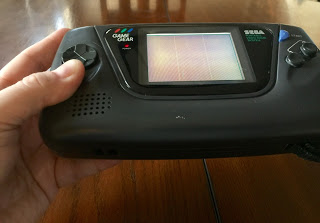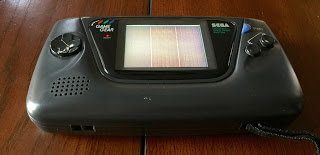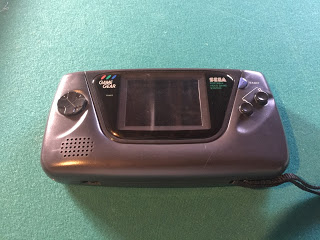My big introduction to Sega was when I picked up my Genesis in 2013 and found myself blown away by the system itself as well as the Sonic games I got with it. A year later Sega would impress me again with the Master System, and then after that with the Dreamcast, and Saturn. I’ve even learned to accept the 32x, and Sega-CD as probably being remarkable for their time, but I will discuss the Sega-CD later. Going off the great impressions I had from Sega’s consoles, I had pretty high expectations last year when I finally picked up a Sega Game Gear. To say the least after all my confidence in the Sega name on hardware, I was disappointed in what I got with the Game Gear.
In the process of shopping for one on eBay, I was shocked at how varied the prices where, ranging from dirt cheap and jumping to the $90+ mark quickly. As I would find out, sadly from personal experience now, there is a reason for that. As it turns out unlike its competitors, Nintendo’s Gameboy, and Atari’s Lynx, the Game Gear has a serious history of just not aging well and finding one still fully functional makes them a bit rare. I paid $40+ for mine and it came with a small pile of games, a case, lighted magnifying lense and a wall charger, and since nothing was mentioned about issues in the description I thought I was buying a fully working unit. Instead I got a Game Gear without external sound and barely audible with headphones, and I had to seriously tilt the screen to get it to work. When I contacted the seller on it he gave me the whole “selling it for a friend” thing some sellers often give you when they sell shit merchandise with an inaccurate description. Good news is he was willing to refund me more than half the cost which I took him up on, since what I got with the Game Gear was at least worth that.
 |
| I photograph best from my good side, a 90° angle |
In the hunt for a fix I could do at home, I came to find out that both issues are extremely common on the Game Gear and DIY fixes aren’t exactly out there unless you’re into soldiering. As it turns out the Game Gear has always had serious reliability issues when it’s come to it’s capacitors, and the older they get the more it happens. In looking up why this was such a big issue for Sega and not Atari or Nintendo, there doesn’t seem to be any explanation out there. The best I can gather, knowing my Sega corporate logic and history, is that Sega wanted to get something out the door since Nintendo and Atari had something in the handheld market by 1989. In an attempt to one-up Nintendo, Sega pushed hard for a color system and in the process used shoddy parts, and inefficient parts that sucked up battery power quickly. Even though they had two additional years to do better, Sega was creating their own proprietary system from scratch that was supposed to surpass its competitors, and this couldn’t have been a small task. With that said though proper R&D, with regards to system longevity seemed lacking. The Game Gear was more or less a quick attempt to plug the sales loss dam and still make Sega look super awesome, and no doubt the sales philosophy was, it’s about today’s sale not tomorrow’s broken system.
Sega was also putting the Game Gear out while their mainstay console, the Genesis, was still in flux on the market especially with new pressure from Nintendo with the SNES. In addition to this 1991 would also be the same year the Sega-CD was released, and this more than likely garnered more of Sega’s R&D budget than the Game Gear. On top of this Sega probably had its eyes on the future console market with potential competition on the horizon from Atari, and Nintendo, as well as new entrants, adding pressure to develop the next big thing first. Because of all this it seems entirely plausible that the Game Gear might have suffered in overall design. It’s not that the Game Gear didn’t have some good titles on it, and that some of the games are well known for good quality gameplay, but what’s the point on a system where you can’t see or even hear them?
 |
| All’s good if you play it flat on a table |
As I’ve written above and written before I’m actually a Sega fan and I’ve been impressed by what their systems have delivered to me in the way of gameplay, and system quality. So it’s a bitter disappointment to find a system that doesn’t seem to have gotten the same level of care or quality as Sega’s other products. I will stand by my love for the Gameboy, and Lynx and point out that Nintendo and Atari made two quality systems that have aged well, and still produce the same quality of gameplay as they did the day the were first played. Sega on the other hand failed in this particular instance.
If you were thinking about buying yourself a Game Gear, my suggestion would be to not buy this particular system on eBay unless it comes from a video game seller with experience in gaming, and a reputation for selling good quality merchandise, so you know you’re getting a tested and fully working system. Otherwise my other suggestion is to see if you can find one in the wild so you can test it out first before buying. Overall, just based on reliability I can’t claim the Game Gear is a good system. The games I have look good on it, but considering I have to hold the screen at nearly a 90 degree angle it made them unplayable, and with barely any sound what’s the point. In a way it’s pretty regrettable that the Game Gear had component issues like this and that time has been so unkind to with regards to these issues. Sadly, it could have been another great system in an era of great handhelds.
